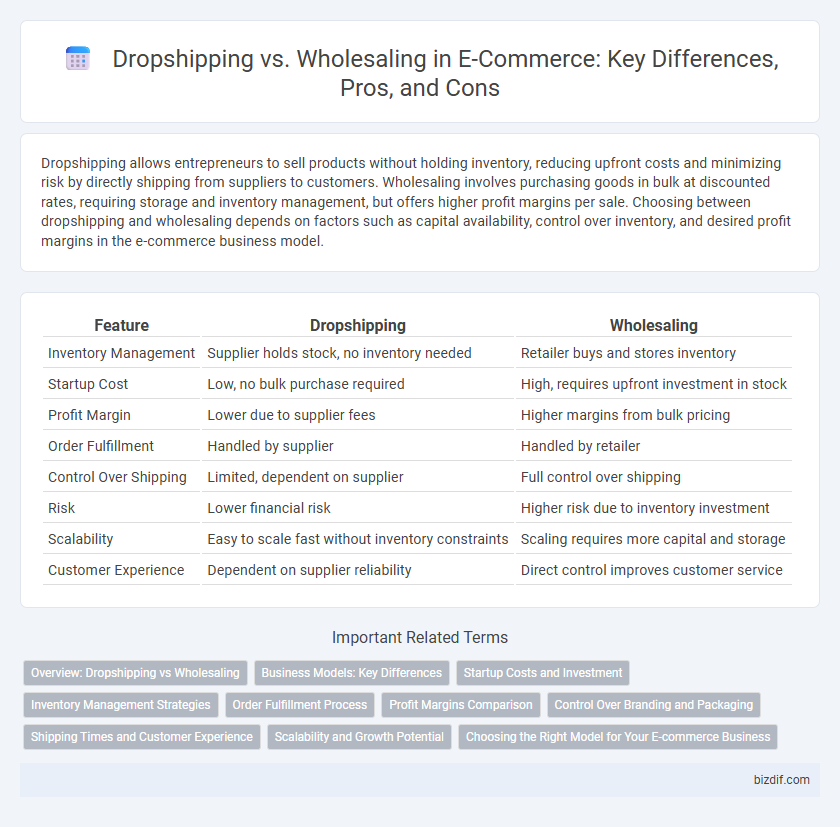Dropshipping allows entrepreneurs to sell products without holding inventory, reducing upfront costs and minimizing risk by directly shipping from suppliers to customers. Wholesaling involves purchasing goods in bulk at discounted rates, requiring storage and inventory management, but offers higher profit margins per sale. Choosing between dropshipping and wholesaling depends on factors such as capital availability, control over inventory, and desired profit margins in the e-commerce business model.
Table of Comparison
| Feature | Dropshipping | Wholesaling |
|---|---|---|
| Inventory Management | Supplier holds stock, no inventory needed | Retailer buys and stores inventory |
| Startup Cost | Low, no bulk purchase required | High, requires upfront investment in stock |
| Profit Margin | Lower due to supplier fees | Higher margins from bulk pricing |
| Order Fulfillment | Handled by supplier | Handled by retailer |
| Control Over Shipping | Limited, dependent on supplier | Full control over shipping |
| Risk | Lower financial risk | Higher risk due to inventory investment |
| Scalability | Easy to scale fast without inventory constraints | Scaling requires more capital and storage |
| Customer Experience | Dependent on supplier reliability | Direct control improves customer service |
Overview: Dropshipping vs Wholesaling
Dropshipping allows retailers to sell products without holding inventory, as suppliers ship directly to customers, reducing upfront costs and risk. Wholesaling involves purchasing bulk inventory at discounted rates to store and fulfill orders independently, offering greater control over stock and shipping times. Each method suits different business models based on factors like capital availability, inventory management, and profit margins.
Business Models: Key Differences
Dropshipping involves selling products directly from suppliers to customers without holding inventory, minimizing upfront investment and reducing risk. Wholesaling requires purchasing bulk inventory and managing storage, offering higher profit margins but increasing capital requirements and operational complexity. The key difference lies in inventory ownership and fulfillment responsibility, affecting cash flow, scalability, and logistical control in e-commerce business models.
Startup Costs and Investment
Dropshipping requires significantly lower startup costs since it eliminates the need for inventory purchase and warehousing, allowing entrepreneurs to launch with minimal capital investment. Wholesaling demands higher upfront expenses due to bulk inventory purchases, storage fees, and sometimes additional staffing, which increases the initial financial risk. Understanding these cost differences is crucial for e-commerce startups when selecting a viable business model aligned with their available resources.
Inventory Management Strategies
Dropshipping eliminates the need for inventory storage by allowing retailers to directly ship products from suppliers to customers, reducing overhead costs and minimizing stock risks. Wholesaling requires businesses to purchase and hold inventory in bulk, providing greater control over stock levels and faster shipping times but increasing storage costs and the risk of unsold products. Effective inventory management strategies in dropshipping rely on robust supplier relationships and real-time inventory tracking, while wholesaling demands accurate demand forecasting and warehouse optimization to avoid overstock or stockouts.
Order Fulfillment Process
Dropshipping relies on suppliers to ship products directly to customers, eliminating the need for inventory management and reducing upfront costs, but may result in longer delivery times and less quality control. Wholesaling involves purchasing bulk inventory and managing the fulfillment process internally or through third-party logistics, offering faster shipping and better control over packaging and customer experience. Efficient order fulfillment in wholesaling can enhance brand reputation, while dropshipping offers scalability with minimal operational complexity.
Profit Margins Comparison
Dropshipping typically offers lower profit margins, often ranging between 10-30%, due to higher per-unit costs and reliance on third-party suppliers, while wholesaling enables retailers to achieve higher margins of 30-50% by purchasing goods in bulk at discounted rates. Inventory management and upfront investment are minimized in dropshipping, but wholesaling benefits from greater control over pricing and stock levels. Understanding these margin differences is crucial for e-commerce entrepreneurs aiming to balance risk, capital, and profitability.
Control Over Branding and Packaging
Dropshipping offers limited control over branding and packaging since products are shipped directly from suppliers with standardized packaging. Wholesaling provides greater control, allowing businesses to customize packaging and include branded materials to enhance customer experience. Effective branding and packaging in wholesaling can increase customer loyalty and differentiate the business in competitive e-commerce markets.
Shipping Times and Customer Experience
Dropshipping often results in longer shipping times due to reliance on third-party suppliers, potentially impacting customer satisfaction and repeat purchases. Wholesaling allows for faster shipping since inventory is stocked and controlled by the seller, enhancing the overall customer experience with timely delivery. Efficient order fulfillment in wholesaling contributes to higher trust and brand loyalty compared to the variable shipping schedules common in dropshipping.
Scalability and Growth Potential
Dropshipping offers high scalability due to low upfront inventory costs and flexible order fulfillment, enabling rapid expansion without significant capital investment. Wholesaling requires larger initial inventory purchases, which can limit growth speed but provides higher profit margins per unit sold. The choice between dropshipping and wholesaling impacts scalability and growth potential based on business model preferences and cash flow capacity.
Choosing the Right Model for Your E-commerce Business
Dropshipping offers low upfront costs and minimal inventory management, making it ideal for e-commerce entrepreneurs seeking flexibility and scalability. Wholesaling requires purchasing bulk inventory, providing higher profit margins and greater control over product quality and shipping times. Selecting the right model depends on your budget, risk tolerance, and long-term business goals in the competitive e-commerce landscape.
Dropshipping vs Wholesaling Infographic

 bizdif.com
bizdif.com